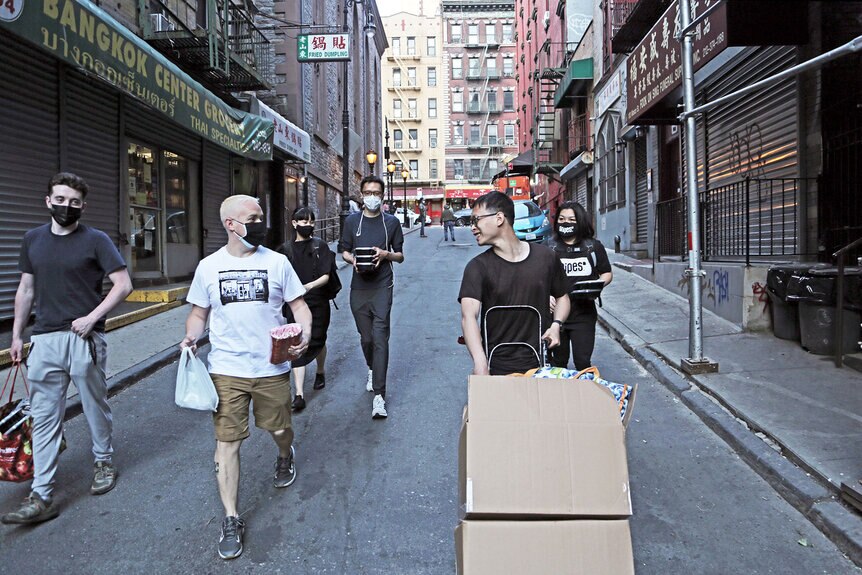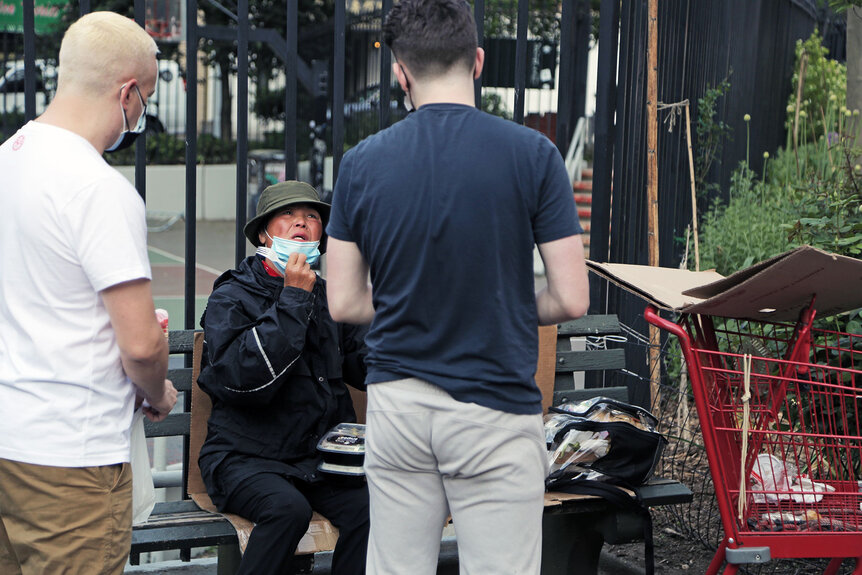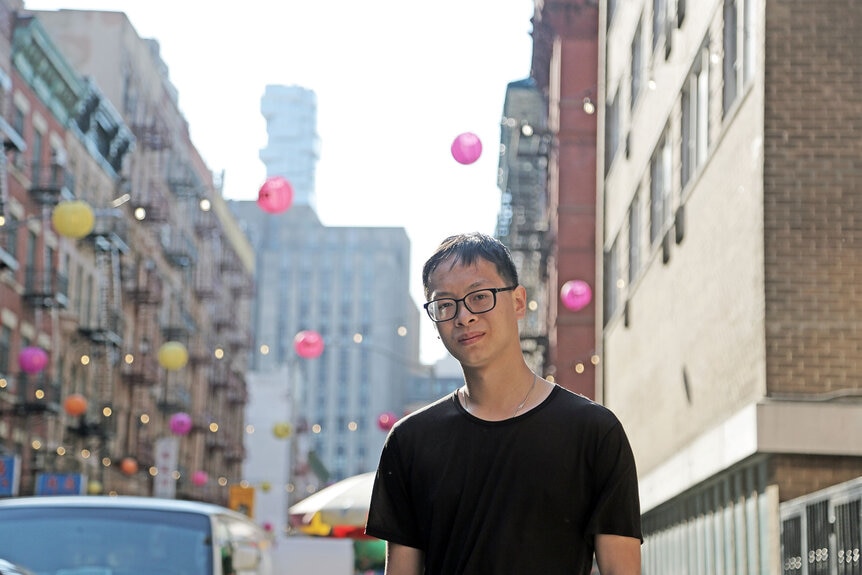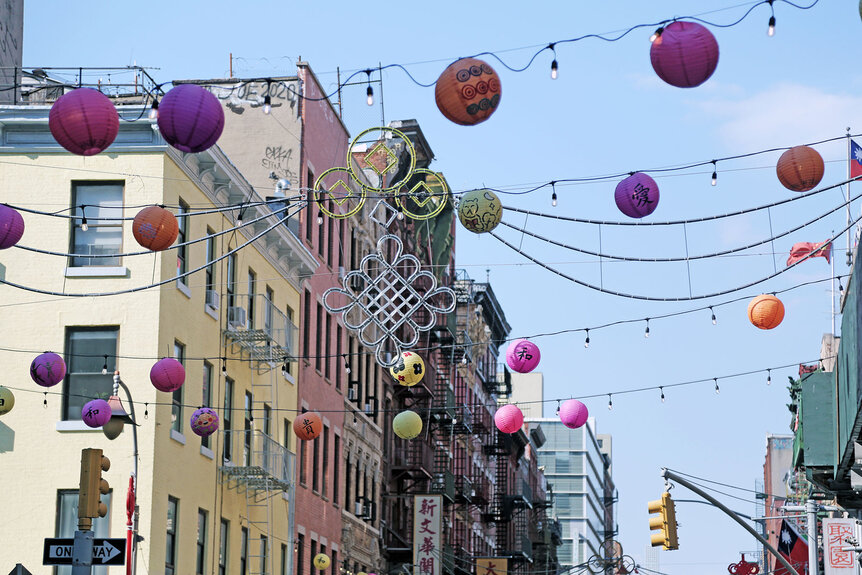Create a free profile to get unlimited access to exclusive videos, breaking news, sweepstakes, and more!
Revitalizing NYC's Chinatown Post-Pandemic, One Meal — And One Lantern — At A Time
In the famed enclave in lower Manhattan, the challenges brought by the COVID-19 pandemic — from struggling businesses to the troubling spike in anti-Asian violence — have been extreme. But the community has still found people and symbols to rally around.
On a spring Monday in New York City, Patrick Mock pushed a handcart containing hundreds of dumplings down a winding alleyway in lower Manhattan’s Chinatown.
Mock, 27, wasn’t alone. About half a dozen masked volunteers trailed him with chopsticks and packaged trays of shrimp shumai, soy chicken, and pork dumplings.
A South Korean woman experiencing homelessness greeted them outside Columbus Park. She took two containers. The group later stopped underneath Manhattan Bridge to distribute dim sum to people in homeless encampments.
Since April 2020, Mock has handed out approximately 70,000 meals across Chinatown.
“In Asian culture we’re always taught to respect our elders, take care of our elders,” Mock told Oxygen.com. “Doing these meals, it’s a way of showing that.”
At the peak of the COVID-19 pandemic, Mock also shuttled fried rice to frontline medical workers.
Mock, who manages 46 Mott Bakery, prepares the meals himself in the back of the quaint eatery. Roast pork rice boxes and lo mein are “always a favorite,” he said.
The idea to feed Chinatown’s more vulnerable citizens, Mock said, was also born out of the food desert sparked by the pandemic.
“We had a supply chain issue in Chinatown,” he said. “Our local farms — no one was working. All of our local veggies dried up and prices shot up. Eggs [were] like $6 a dozen. There were only like four or five stores open at the height of the pandemic.”
The elderly and homeless, he said, were increasingly sustaining themselves solely on cups of noodles and boiling water.
“They would fill it up with hot water, eat all the noodles, and come back to the store and fill it up with more hot water and drink it as a soup,” he said. “That’s where I started realizing some of these elderly might be homeless.”
Chinatown was among the first New York City neighborhoods to feel the virus’ acute economic pinch.
“Everyone thought the virus was in Chinatown,” said. “Because of all the xenophobia and racism ... we lost the busiest season of the year, which is our Lunar New Year.”
In January 2020, tourists dried up, noodle houses shuttered, and the once-pulsating ethnic enclave with its crowded sidewalks became a ghost town. Blocks away, however, Little Italy, was “bustling,” Mock said. More than a year later, the downturn has persisted.
“Chinatown used to be a 24-hour destination, but now it’s only running on eight,” he said. “We rely heavily on tourism down here. It hurts.”
Mock's eatery hung on by a thread through the pandemic, he said. Some neighboring businesses weren’t as lucky. His bakery saw a 60 to 70 percent loss in revenue.
“It came to either we stay open and grind it out and see how business will be like or we shut down for good,” he explained.
Mock gained citywide notoriety last summer after a tense exchange with Mayor Bill De Blasio. The entrepreneur, who felt abandoned by the city officials, since made it his mission to bring business back to Chinatown post-pandemic.
Also at the top of Mock's list was conquering the bleak aesthetic that had come to define the neighborhood.
“During the peak of COVID all the shops were closed and Chinatown was pitch black dark,” Mock said. “It was just empty, quiet, gloomy.”
In January, with the help of volunteers and lighting professionals, Mock strung up 250 lanterns down a small section of Mott Street. The vibrant installation, dubbed Light Up Chinatown, has grown to 400 lanterns — and spread to the nearby Bowery and Bayard Street. Hundreds more are in the works.
“It’s a symbol of hope and it’s also the light at the end of the tunnel,” Mock said.
The vibrant project has raked in nearly $100,000 in donations and even attracted praise from actor Will Smith, who also kicked in $10,000. Donors could add their names to the lanterns for $40 or take home their own if they gave $150.
Joanne Kwong, 45, the second-generation owner of Chinatown emporium Pearl River Mart, sourced the nylon lanterns used in the display. She enlisted five artists and a calligraphy specialist to hand-paint hundreds of lanterns with auspicious symbols.
The sea of lights serves another purpose, too: keeping Chinatown safe amidst a rise in anti-Asian hate.
“Almost everybody that we knew was worried about their elders being safe in the streets, so it alleviated a couple of problems,” Kwong told Oxygen.com. “One, was really encouraging people to come back to Chinatown to frequent small businesses. Two, was to make the streets safer for everyone. And three, was just to inject hope and a sense of community into a time where everyone was separated and the future seemed really bleak.”
In 2020, the FBI warned hate crimes targeting Asian-American and Pacific Islanders could spike countrywide as the virus’ grip tightened. Since then, anti-Asian hate crimes have surged in New York, and other major cities.
In March, trio of Atlanta-area massage parlors were targeted by a gunman. Eight people were killed, six of whom were Asian women, and officials suspect the shooting was racially motivated.
“These initiatives of where we put lanterns up to protect the elderly, or where we’re providing meals — it’s taking that idea of where you take care of your elders in the Chinese community,” Barbara Leung, 31, who works at Nom Wah Tea Parlor, told Oxygen.com.
New York alone has seen roughly a 400% jump in such incidents. A total of 78 anti-Asian hate crime complaints have been investigated in 2021, compared to only 19 at this time last year, according to city police data.
Nationally, at least 6,603 suspected anti-Asian bias incidents were reported in the past year, according to the Stop AAPI Hate Reporting Center.
Many of Chinatown’s residents suspect a toxic mixture of fear, misinformation, and political rhetoric are to blame.
“Our community’s businesses suffered starting January 2020 due to people being very hateful in a lot of ways,” New York State Assemblymember Yuh-Line Niou told Oxygen.com.
“People were spreading messages about how unclean our food was, and all these things, echoing what the president was saying.”
Niou cited former President Donald Trump’s pejorative slang, including his repeated referral to the coronavirus as the “kung flu” or the “China virus.”
“It was really painful to hear, to watch, to see — I think it’s really important to have something that draws people back to our communities,” Niou added.
On May 18, the House of Representatives passed an anti-Asian hate crime bill that makes it easier to investigate, record, and prosecute hate crimes at the federal level. The bill expedites review of COVID-19 hate crimes, includes a network of hate crime tiplines, and provides grants for police to train officers to respond to such incidents.
It received bipartisan approval with a 364-62 margin. President Joe Biden signed the bill into law Thursday.
“I was still startled by how many people voted ‘no,’" Niou said, however. “It was pretty gross.”
The bill also stirred indifferent reactions elsewhere in Chinatown.
“I always fear for my safety but what can I do about it?” Mock quipped. “I’m a New Yorker. I gotta keep grinding it out. It’s what New Yorkers do.”




















